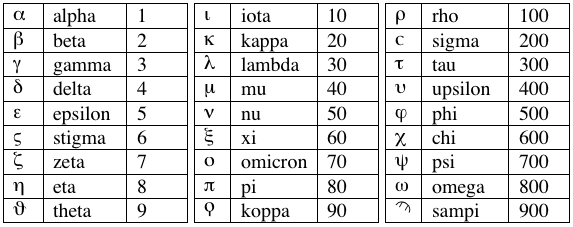Especially when dealing with documentary papyri, it is important to understand how the ancient Greeks represented numbers. Here is a chart outlining the numeric values for different letters of the Greek alphabet. Some letters (stigma, koppa, and sampi) continued to be used as numbers even after they were no longer used by Greeks as letters.

Basically, the letters of the alphabet were used to each represent a different number, and when these letters were combined, the number represented was the sum of the values of the individual numbers. A few examples will make this clear:
IB = 12, since I=10 and B=2
TM = 340, since T=300 and M=40
Dates
Unlike the modern dating system, which assigns a number to each year (e.g. 2004), the Egyptian system named each year after the current ruler. In the Ptolemaic and Roman eras, this was done by saying something like, "The fourth year of the rule of Augustus". Later, in the Byzantine era, the year was identified by the old Roman method using the names of the current consuls (this was an effective method since consuls only served for the length of one year).
Dating of days and months was quite similar to the modern method. Although the calander system changed somewhat over time, dates were generally given using the name of the month and the number of the day (e.g. "Pauni 13", as we would say "June 7").
Currency
The most common units of money in Egypt were the drachma and the obol. Below is an overview of the currency units:
one talant = 6,000 drachmas
one mna = 100 drachmas
one stater = 4 drachmas (one tetradrachm)
one drachma = 6 obols = 48 chalkous
one obol = 8 chalkous
Rapid inflation occured in the fourth century, making it difficult to compare prices from different eras.





